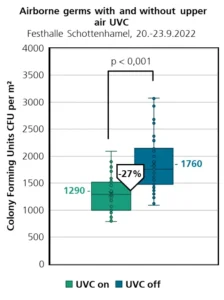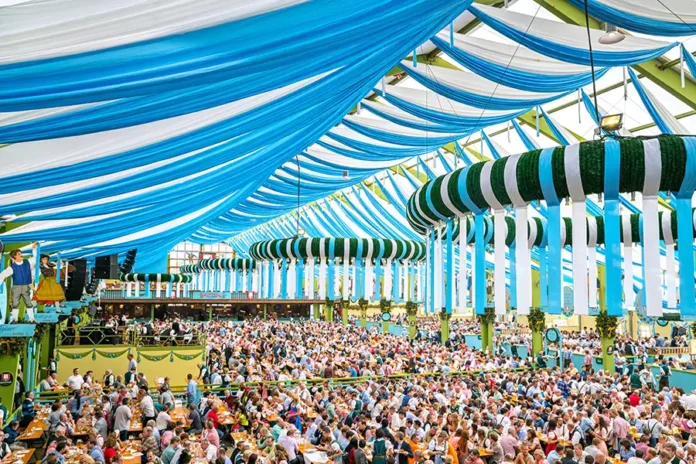By Marc de Samber, research fellow; Dirk Seifert, UV-C Application Specialist;
and Martin Creusen, Standards and Regulations professional, Signify
Large indoor events, such as tradeshows or festivities, bring together crowds of people in high-density settings. These people often are highly active, quite noisy and move around a lot. This leads to high levels of exhaled air from the crowds, with a substantial risk of airborne disease spreading, particularly during periods of flu waves or other respiratory diseases. The possible presence of superspreaders in the crowd may add to an increased infection risk.
Event organizers often rely on natural or mechanical ventilation for lowering airborne infection risks. Ventilation options, however, may be limited and or even not preferred because of discomfort from cold or warm outdoor air inflow or from unfiltered, recirculated airflow from HVAC systems. Also, ventilation with 100% outdoor air has the drawback of consuming high levels of energy. Hence the interest in creating a next level of energy-efficient infection prevention, independent of people’s behavior.
UV-C Installation
To reduce the risk of COVID-19 airborne disease transmission during the yearly two-week Oktoberfest event, one of the world’s largest public festivals, the effectiveness of UV-C was tested. For this purpose, 14 UV-C luminaires were installed in the upper part of one of the festival tents (accommodation capacity: 6,000 seats covering a 4,800 m2 area) on the Theresa Meadow in Munich. The 10-meter mounting height ensured that the safety threshold limit values (TLVs) easily could be guaranteed. The commissioning measurements confirmed that the UV-C values did not exceed the 254 nm exposure limits for eyes and skin, as set by ACGIH and ICNRP. 1,2
The preceding UV-C simulations, performed before installing the UV-C luminaires, indicated that the average irradiance level in the central part of the festival tent space was 3.2 mW/m2, which corresponds to an hourly fluence of 11.5 J/m2. Assuming a susceptibility in air of k=0.377 m2/J for Coronaviruses like SARS-CoV-2 3, the so-called equivalent air changes per hour could be determined as being 4.3 ACH. Assuming an average four-hour exposure time, the Wells-Riley model estimates that the UV-C installation could reduce the infection risk by around 70%, assuming a well-mixed air scenario.
Test Protocol
To measure the UVGI efficiency in the festival tent, in a real-life setting, the deactivation of naturally present airborne organisms, such as bacteria and fungi, was evaluated. These organisms are known to have a relatively low sensitivity to UV-C irradiation, compared to the more fragile viruses, such as the targeted SARS-CoV-2 virus. This efficiency measurement method, based on the use of a (naturally present) background airborne bacterial and fungi load, proved to be very suitable as an indicator for the evaluation of hygienic methods in real-life situations and an innovative approach for microbiological air quality evaluation. Earlier work at Fraunhofer, with the authors’ company, has confirmed this in other case studies in cinemas, supermarkets and mall settings. 4,5
Air samples were taken on four subsequent days during the ongoing festivities, with an on-and-off status of the UV-C luminaires, during a full day. Sampling was done in the middle of the festival tent, with air sampling carried out every two hours. Organisms were captured by sucking 100 litre of air through a gelatine filter (50 l/min); five subsequent filters were taken during approximately 20 minutes at each sampling time. The filters were next processed according to standard protocols for Indoor Microbiology in the microbiology lab of Fraunhofer IBP and, after three and 10 days of incubation, the number of colony forming units (CFU) for bacteria and fungi were counted.
Discussion Results

During the days that the UV-C luminaires were operating, the bacteria and fungi count was reduced with 27% from 1,760 CFU to 1,290 CFU (Chart 1). Based on the measured concentrations of air germs (bacteria and fungi) and an assumed basic ventilation level of 1.5 ACH, the UV-C-induced eqACH for these bacteria and fungi was around 0.55 eqACH. 6 This is a factor 8 lower than the calculated 4.3 eqACH for SARS-CoV-2 (based on the average irradiance level) but can be explained by the large difference in UV-C susceptibility between viruses and bacteria/fungi. Viruses like SARS-CoV-2 are quite easy to inactivate and have a UV-C susceptibility which is up to 15 times higher than the bacteria and fungi measured in this experiment. 7
For future installations, reducing the mounting height to a height of about five meters would double the irradiance level and still guarantee a safe installation by complying with the TLVs. As a result, the eqACH could be doubled (i.e. >8) and the infection risk further reduced with another 40%.
Conclusions
The experiment demonstrates that UV-C technology easily can be installed in a cost-effective and energy-efficient manner, without major challenges, to reduce the infection risk for large groups of people during mass indoor gatherings. Without drastically changing the infrastructure of the tent, the equivalent disinfection performance of more than four air changes per hour could be established during this large indoor event.
The effectiveness of UV-C for other prevalent viruses, such as the Human Influenza Virus or the Respiratory Syncytial Virus (RSV), also can be evaluated. UV-C has shown to be effective for a wide range of pathogens, since the first installations in schools, dating back to the beginning of the 20th century. This supports a large scale of application opportunities for the well-established, but still relatively unknown and underappreciated, UV-C technology.
References
- ACGIH 2022 The American Conference of Governmental Industrial Hygienists, UVC threshold limit values Ultraviolet radiation TLVs
- ICNIRP Guidelines “On limits of exposure to Ultraviolet radiation of wavelengths between 180 nm and 400 nm (incoherent optical radiation)” published in: HEALTH PHYSICS 87(2):171-186; 2004
- C.M. Walker and G. Ko, Effect of Ultraviolet Germicidal Irradiation on Viral Aerosols, Environ. Sci. Technol. 2007, 41, 5460-5465
- W.K. Hofbauer and M. Baßler, Efficiency of UVC radiation as an air disinfectant in a real environment, Proceedings of Indoor Air Conference 2022, June 12th to 16th Kuopio, Finland, paper 1795, 2 pp.
- G. Grün, IBP-Bericht FM-005/2022/200: Raumlufthygiene und Einsatz von Luftreinigungs-technologien in Filmtheatern in der Covid-19-Pandemie (CineCov) – Schlussbericht. 31.10.2022. pp. 65-82.
- Melvin First, Stephen N. Rudnick, Kevin F. Banahan, Richard L. Vincent & Phillip W. Brickner, Fundamental Factors Affecting Upper-Room Ultraviolet Germicidal Irradiation—Part I. Experimental, Journal of Occupational and Environmental Hygiene, 4:5, 321-331, 2007, DOI: 10.1080/15459620701271693
- W. Kowalski, Ultraviolet Germicidal Irradiation Handbook, UVGI for Air and Surface Disinfection, Springer, DOI 10.1007/978-3-642-01999-9, 2009
Marc de Samber is a research fellow at Signify Research. He holds a master’s degree in Inorganic and Analytical Chemistry and obtained a PhD in Chemistry (Photochemistry) from the University of Leuven (Belgium). He also has studied human physiology and immunology in his PhD period. Since the outbreak of the COVID-19 pandemic, de Samber dived into the new field of UVC surface and air disinfection for disease transmission prevention, leveraging his skills in lighting, biochemistry, photochemistry, physiology, immunology and pathology.
Since 2004, Dirk Seifert has worked at Signify (aka Philips Lighting) in the Department Lighting Application Services for support and application of lighting and control systems. He has studied in Ilmenau and Bratislava in the technical, optical and lighting field and graduated from the University Ilmenau. He is one of authors and editors of the German book “Beleuchtungstechnik Grundlagen” (“Lighting Technology”) and he is an active member of the German Lighting Society and German DIN standardization groups. Since the outbreak of the Pandemic, he has been involved in many practical applications for surface and air disinfection, applying UV-C systems in a wide range of projects in Germany, Austria and Switzerland.
Martin Creusen is a Standards and Regulation professional at Signify in the Netherlands. He holds a master’s degree in physics and a professional doctorate in engineering (PDEng) from the Eindhoven University of Technology. During his 23 years at Philips/Signify, Creusen worked in various product divisions, ranging from Semiconductors and Components (i.e. Mobile Display Systems) to Lighting (i.e. Advanced Development, Research and now S&R). In the last 2.5 years, he has focused on the field of UV-C technology, especially on the new opportunities for indoor air disinfection as key mitigation tool in the on-going COVID-19 pandemic.
For more information, email [email protected], [email protected] and [email protected] or visit www.signify.com.





